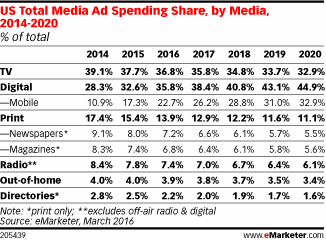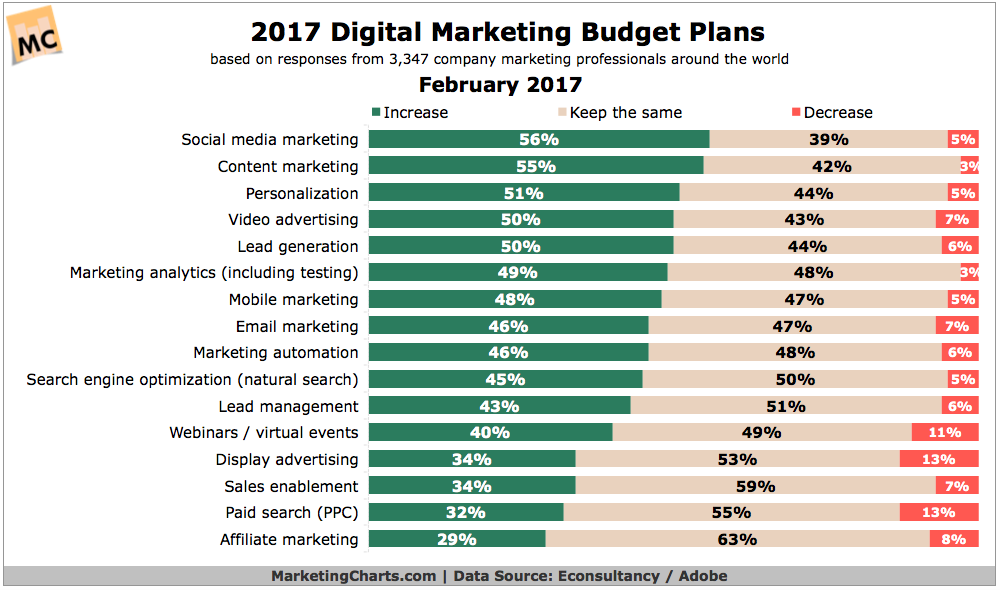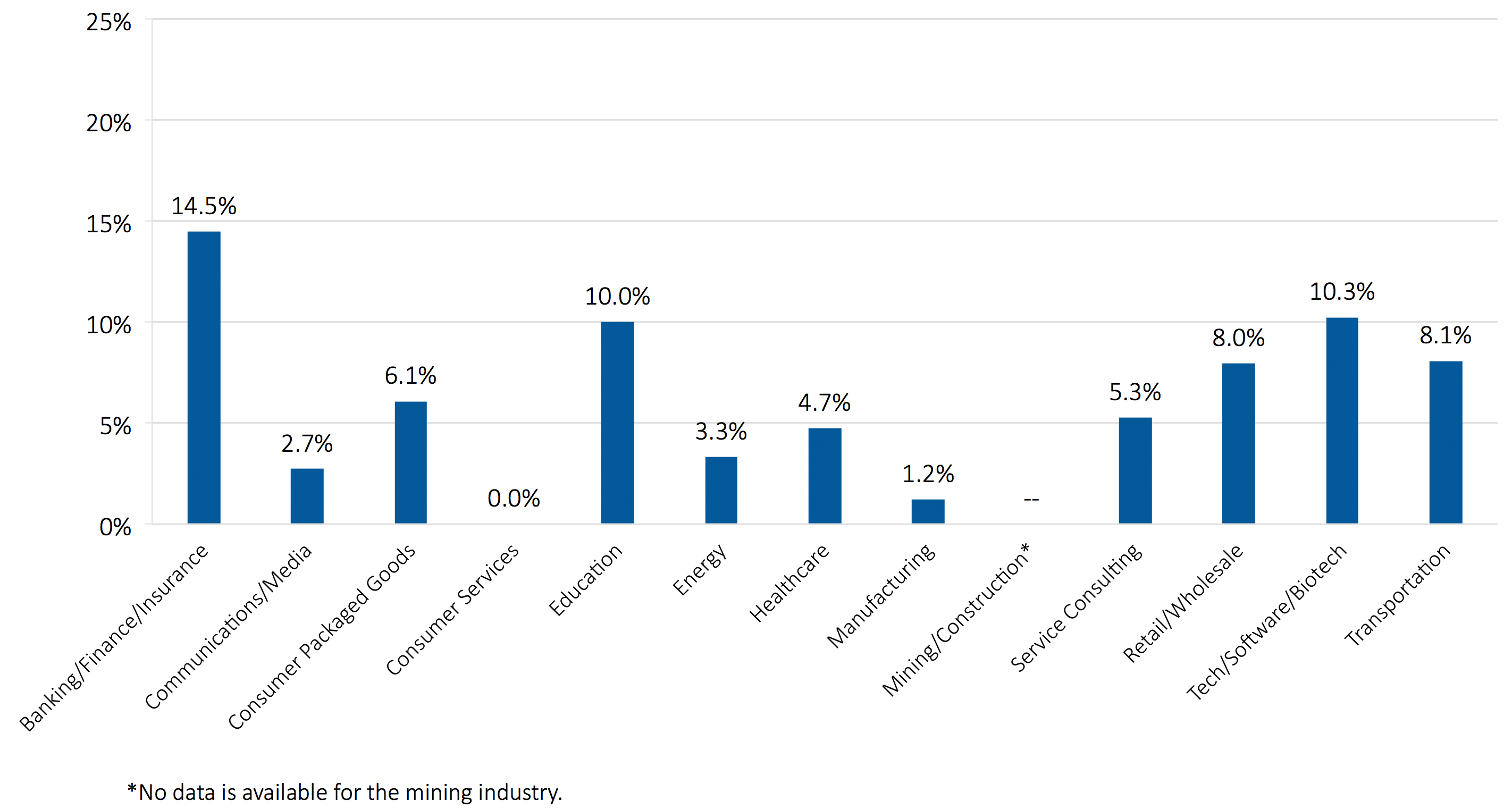Digital marketing is becoming more significant each year, and in 2018 you will struggle to find even small local businesses that aren’t spending money online. Traditional offline advertising is shrinking year on year while digital marketing is booming.
A growing number of businesses recognize the opportunity that the internet represents, the chance for them to overtake their ancient competitors.
But many of these local businesses don’t know how much to spend on digital marketing. They might not understand which methods are best for them and they are unsure about how much of their total marketing budget to allocate to online advertising.
In this article, we will look at a selection of fascinating data from sources that show the average digital marketing spend of companies and their predictions for the future. Through this data, we will explain how to choose a budget and allocate it efficiently.
Digital Marketing Spend Data – How Much to Spend on Digital Marketing
According to reports from Forrester Research and also eMarketer, in 2018 the average company is expecting to allocate 41% of their marketing budget to digital methods. That number is up from previous years and just goes to show how vital large companies believe online marketing is.
It’s an interesting data point because it gives smaller businesses a little bit of information about what their larger counterparts are doing. However, that’s not to say that small companies should allocate the same percentage to their online efforts.
Small and large businesses have some similarities, but the differences are vast when you look at optimal marketing.
Most small businesses would benefit from allocating a much higher percentage of their overall 2018 marketing budget to online advertising. This more substantial portion is because they can’t benefit from brand awareness campaigns in traditional media in the same way which large companies can.
Instead, they should focus on direct, trackable and scalable advertising using digital marketing.
The reports go on to explain that search engine marketing represents the largest chunk of that digital marketing spend. Companies recognize the potential of SEO, and many would argue that search engine marketing has one of the highest ROI’s of all marketing methods.
In second were online display, i.e., banner ads and online video. Seeing online display in the second position shouldn’t be surprising, PPC has a fantastic reach and because it’s so easy to track it’s ideal for small businesses who need to make every cent of their 2018 marketing budget count.
Another surprising data point in the reports was that social media marketing budgets are expected to represent 25% of online spend, with a 17% annual growth rate predicted. While advertising on social media can be extremely effective, reach from Facebook pages is down significantly but this doesn’t seem to have impacted companies’ allocations.
Finally, the data shows that digital marketing is growing at an 11% compound annual growth rate, with the bulk of that growth coming from online video.
Choosing a Budget
All of the data is showing that businesses of all sizes are dedicating more and more capital to digital marketing each year. But figuring out how much to spend on digital marketing can still be complicated.
The U.S. Small Business Administration recommends that companies set aside 8% of their gross revenue for marketing. This should quickly allow you to calculate your total marketing budget and from there, you can decide what percentage to spend on digital.
As we can see from the data, most companies are using around 50% of their overall marketing budget on digital. However, the data skews slightly because of larger companies who benefit so much from offline advertising through traditional methods.
For smaller companies, the percentage spent on digital marketing is likely to be much higher because the cost of traditional advertising is often prohibitive. In contrast, digital marketing can be affordable, and it has the potential to generate a high ROI.
The budget that you pick needs to match up perfectly with the goals that you have for your company.
If you want to grow your website traffic three-fold and bring in more leads, then you need to ensure that the budget which you set is going to allow you to do that. Therefore, it’s important that you look at what you want to achieve and work back from there. If you want big results, you need to be willing to spend the money that’s needed to achieve that.
Obviously, the amount that you spend is going to correlate strongly to the sales results for the period. The amount that you should spend depends heavily on your goals, the industry you work in and the customers that you are trying to target.
Some markets are more receptive to digital marketing than others, especially if your ideal customer isn’t regularly using the internet.
On the other hand, if most of your customers spend time online, have social media accounts and watch online video, digital marketing is one of the best ways to reach them. In this day and age, people don’t watch TV advertisements or listen to the radio, and even fewer read newspapers.
Those traditional marketing tactics are slowly dying out, being replaced by digital marketing which can be tracked to the tiniest percentage. This means that you know how and where your budget is being spent, allowing you to monitor and tweak your campaign as it’s running.
Allocating Your Budget Across Different Methods
Once you have decided on your digital marketing budget, you need to figure out how you are going to allocate that budget across different methods for the greatest ROI. Data from Econsultancy showing how 3,347 firms are allocating capital month on month gives you a cross-industry look at how companies are reading the market.
 The data shows the two areas where companies are looking to invest more heavily are social media marketing and content marketing, with a 56% and 55% increase respectively.
The data shows the two areas where companies are looking to invest more heavily are social media marketing and content marketing, with a 56% and 55% increase respectively.
On the flip side, only 5% and 3% of companies are looking to decrease spending in these two areas. This small decrease just goes to show that the ROI of digital marketing is so high that marketing professionals are looking to double-down on their investments in the space.
At the bottom end of the scale, you can see that PPC has a respectable 32% of respondents increasing their budget, but 13% are looking to decrease spending. Naturally, there’s still growing PPC spend across the market, but with rising costs on networks like Facebook, the benefits are slowing.
When you compare these numbers to traditional channels the results are shocking, even affiliate marketing with the lowest net increase in spending is far above traditional media growth. In fact, data from the CMO survey shows that conventional spend is down 2%, while digital spend is up 13% for the same period.
 In 2017, we saw the first time in history that digital spend surpassed total TV advertising spend in the US, with $72.01 billion spent on TV and $77.37 billion spent on digital marketing. The tide is turning, and this gap is expected to widen in 2018 as companies increase their digital advertising spend and retract capital from TV advertising.
In 2017, we saw the first time in history that digital spend surpassed total TV advertising spend in the US, with $72.01 billion spent on TV and $77.37 billion spent on digital marketing. The tide is turning, and this gap is expected to widen in 2018 as companies increase their digital advertising spend and retract capital from TV advertising.
Some estimates suggest that by the year 2020, digital spend will be 36% higher than total TV advertisement in the USA. For small and large businesses, the benefit of pursuing digital is clear; you can track your results and figure out your ROI.
Tracking isn’t as easy to do with traditional advertising options, and that means that companies find it difficult to know if their advertising is profitable. With digital, you can see the exact number of people who are clicking through, and this makes calculating the cost per person much more straightforward.
